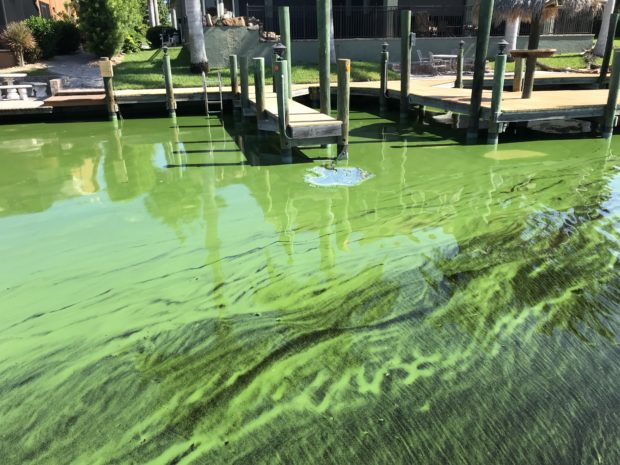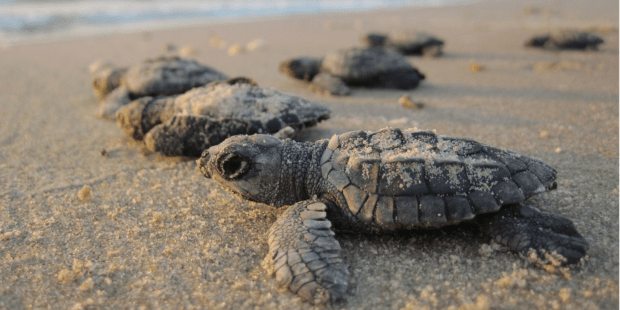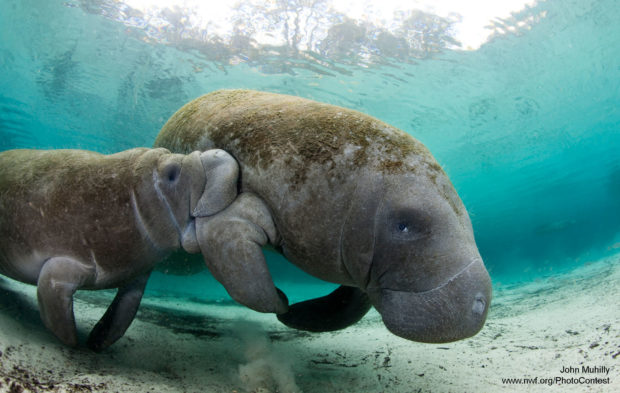We have much more to do and your continued support is needed now more than ever.
Everglades Restoration Will Help End Florida’s Wildlife Crisis

Yet another bout of toxic green slime, mixed with the worst red tide Florida has seen in over a decade, has created a perfect storm for Florida’s wildlife and residents and an unprecedented summer of devastation. Dead manatees, sea turtles, dolphins, cormorants, pelicans, a 26 foot whale shark, and fish by the thousands have clogged Florida’s Gulf Coast waters this summer – and it is showing no signs of stopping. How did we get here? Decades of altering the way water flows through South Florida, coupled with increased nutrient pollution and climate change, causes these recurring blue green algae outbreaks and can contribute to prolonged red tide events like the one happening now.

Blue-Green Algae
The very quality that makes South Florida so special – for anglers, tourists, and locals alike – is the same thing we’ve disrupted: water. Water once flowed slowly south from Lake Okeechobee – the liquid heart of the Everglades – into Florida Bay and the Keys. Now, we’ve severed this connection by building a dike around the lake. When water levels in the lake get too high, the U.S. Army Corps of Engineers discharge billions of gallons of polluted water to the east and west coasts through the St. Lucie and Caloosahatchee Rivers. The nutrients in Lake Okeechobee’s waters fuel toxic blue green algae outbreaks both in the lake and in the delicate Caloosahatchee and St. Lucie estuaries. The below graphic from the Everglades Foundation shows the way water currently moves in Florida compared to the way it should move.
This has become a recurring nightmare for Florida’s wildlife and residents. In 2016, the discharges were so bad that Florida’s Governor Rick Scott declared a state of emergency that lasted for 242 days. This year, thick, guacamole-like slime has coated Lake Okeechobee since early June. In early July, NOAA estimated that 90% of Lake Okeechobee – the second largest freshwater lake located entirely within U.S. borders – was smothered by this blue-green algae. As the Army Corps discharges this water to the east and west coasts to relieve pressure on the dike, the blue-green algae spreads through the Caloosahatchee and St. Lucie Rivers and into coastal estuaries and beaches. This summer, the outbreaks have closed businesses from hotels and fishing guides to Florida Sportsman magazine, and prompted Florida’s Governor to declare a state of emergency in July for seven Florida counties. In the St. Lucie, the water was 10 times too toxic to even touch.
Red Tide Outbreak
Meanwhile, red tide has plagued southwest Florida since last fall, turning coastal waters that normally brim with wildlife into a red-tinted wasteland. Red tide is a type of marine algae that naturally occurs offshore but can be exacerbated when it is blown closer to shore, fertilized by nutrient pollution and fueled by warm, shallow waters. This explosive growth can produce toxins that kill fish and wildlife, make shellfish dangerous to eat, and make the surrounding air difficult to breathe for beachgoers and coastal residents.
Typically, red tide blooms occur from late summer and early fall. This year though, it hasn’t stopped, poisoning nesting sea turtles, manatees, dolphins, sea birds, and countless other fish and wildlife. On August 14, Florida’s Governor declared another state of emergency in seven coastal counties because of the current outbreak. The Florida Fish and Wildlife Conservation Commission (FWC) has documented nearly 300 sea turtle deaths in Gulf waters off Florida’s southwest coast since the red tide began last October, including the endangered Loggerhead and Kemp’s ridley sea turtles. At least 300 tons of dead marine creatures have been removed from Sanibel Island’s beaches alone. In Lee County, workers have pulled more than 2.7 million pounds of dead fish and wildlife from beaches. Preliminary reports by the FWC show that more than 100 manatees have died this year due to red tide.

The Solution:
Although red tide events are naturally occurring, they can be fueled by nutrient pollution runoff from shore. The blue-green cyanobacteria outbreaks that clog up Lake Okeechobee and are discharged into Florida’s rivers and coastal estuaries are the result of manmade pollution, and are adding more nutrients to Florida’s warm coastal waters. Fortunately, there is a solution to reducing the damaging discharges – Everglades restoration.
We need to change the way water moves through the state to mimic the historic flow of clean freshwater from Lake Okeechobee south, instead of diverting it to the east and west coasts. Congress must authorize the construction of a critical reservoir south of Lake Okeechobee as part of the water resources bill before Congress. This project will reduce the damaging discharges to the fragile coastal estuaries by more than 50%, instead cleaning and sending that water south to the Everglades and Florida Bay where it is desperately needed.

Additionally, the federal government must increase federal funding for Everglades restoration to implement key projects that will help improve the health of the overall system. Implementing Everglades restoration projects depends on an equal partnership between the state of Florida and the federal government as outlined in the Comprehensive Everglades Restoration Plan. In recent years, the state of Florida has funded Everglades restoration at more than $200 million per year, while federal appropriations, which are intended to match the state’s, have decreased dramatically. In order to maximize the benefits of Everglades restoration and meet the state’s cost share, the President must request full funding for the US Army Corps of Engineers’ to restore America’s Everglades, and Congress must subsequently appropriate full funding to reduce the damaging discharges and send water south.

Equally important is maintaining strong water quality safeguards and standards to protect our waters and wildlife across the nation. Toxic algae is not just limited to South Florida – it is clogging our nation’s waters from the Great Lakes to the Gulf. Now is the time to be strengthening not weakening critical safeguards like the Clean Water Act.






















